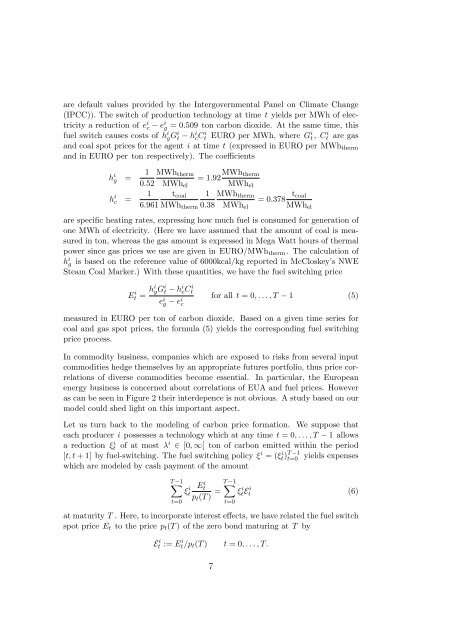A quantitative approach to carbon price risk modeling - CiteSeerX
A quantitative approach to carbon price risk modeling - CiteSeerX
A quantitative approach to carbon price risk modeling - CiteSeerX
Create successful ePaper yourself
Turn your PDF publications into a flip-book with our unique Google optimized e-Paper software.
are default values provided by the Intergovernmental Panel on Climate Change<br />
(IPCC)). The switch of production technology at time t yields per MWh of electricity<br />
a reduction of e i c − e i g = 0.509 <strong>to</strong>n <strong>carbon</strong> dioxide. At the same time, this<br />
fuel switch causes costs of h i gG i t − h i cC i t EURO per MWh, where G i t , C i t are gas<br />
and coal spot <strong>price</strong>s for the agent i at time t (expressed in EURO per MWh therm<br />
and in EURO per <strong>to</strong>n respectively). The coefficients<br />
h i g =<br />
h i c =<br />
MWh therm<br />
1<br />
= 1.92 MWh therm<br />
0.52 MWh el MWh el<br />
1 t coal 1 MWh therm<br />
= 0.378 t coal<br />
6.961 MWh therm 0.38 MWh el MWh el<br />
are specific heating rates, expressing how much fuel is consumed for generation of<br />
one MWh of electricity. (Here we have assumed that the amount of coal is measured<br />
in <strong>to</strong>n, whereas the gas amount is expressed in Mega Watt hours of thermal<br />
power since gas <strong>price</strong>s we use are given in EURO/MWh therm . The calculation of<br />
h i g is based on the reference value of 6000kcal/kg reported in McCloskey’s NWE<br />
Steam Coal Marker.) With these quantities, we have the fuel switching <strong>price</strong><br />
E i t = hi gG i t − h i cC i t<br />
e i g − e i c<br />
for all t = 0, . . . , T − 1 (5)<br />
measured in EURO per <strong>to</strong>n of <strong>carbon</strong> dioxide. Based on a given time series for<br />
coal and gas spot <strong>price</strong>s, the formula (5) yields the corresponding fuel switching<br />
<strong>price</strong> process.<br />
In commodity business, companies which are exposed <strong>to</strong> <strong>risk</strong>s from several input<br />
commodities hedge themselves by an appropriate futures portfolio, thus <strong>price</strong> correlations<br />
of diverse commodities become essential. In particular, the European<br />
energy business is concerned about correlations of EUA and fuel <strong>price</strong>s. However<br />
as can be seen in Figure 2 their interdepence is not obvious. A study based on our<br />
model could shed light on this important aspect.<br />
Let us turn back <strong>to</strong> the <strong>modeling</strong> of <strong>carbon</strong> <strong>price</strong> formation. We suppose that<br />
each producer i possesses a technology which at any time t = 0, . . . , T − 1 allows<br />
a reduction ξt<br />
i of at most λ i ∈ [0, ∞[ <strong>to</strong>n of <strong>carbon</strong> emitted within the period<br />
[t, t + 1] by fuel-switching. The fuel switching policy ξ i = (ξt) i T t=0 −1 yields expenses<br />
which are modeled by cash payment of the amount<br />
∑<br />
T −1<br />
ξt<br />
i<br />
t=0<br />
Et<br />
i T −1<br />
p t (T ) =<br />
∑<br />
ξtE i t i (6)<br />
at maturity T . Here, <strong>to</strong> incorporate interest effects, we have related the fuel switch<br />
spot <strong>price</strong> E t <strong>to</strong> the <strong>price</strong> p t (T ) of the zero bond maturing at T by<br />
t=0<br />
E i t := E i t/p t (T ) t = 0, . . . , T.<br />
7
















